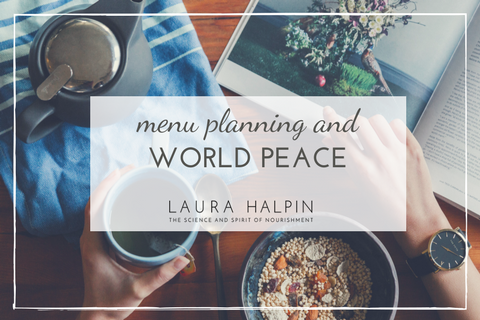
Menu Planning and World Peace
It’s becoming obvious: menu planning and world peace go hand-in-hand.
Lately, no matter what the health issue we’re addressing, I find myself circling back to the practice of menu planning with my clients. Menu planning can be done in countless ways and really isn’t complicated at all. Perhaps because it is uncomplicated and easy, we assume it is not important. Yet menu planning is a necessary foundation on which healthy eating habits rest.
At the risk of stating the obvious (and also because the obvious is often important!), here are a few benefits of menu planning, no matter how busy you are:
1) Menu planning saves time every single week, every single day, multiple times a day. I get in a rut where I feel I don’t have time to sit down and plan. Yet, given the time we all waste looking into the refrigerator, going on multiple trips to the store, wandering the aisles, and going out to eat when we can’t come up with any ideas…we really don’t have time NOT to plan a menu. The busier we are, the more we need a plan.
2) Menu planning saves money. With a plan, I am much more decisive about what I need and don’t need when I shop. I eliminate impulse buys. I save gas, time, and wasted food. Glorious.
3) Menu planning helps us stay on a healthy track. It’s when we’re hungry and don’t have a plan that our best intentions whither. The stress of not having a plan makes our good intentions whither even further.
4) Menu planning means our kids are more open to eating what is healthy and/or new. We’ve learned that toddlers have an easier time with transitions when they know what’s coming. Obvious and important: we all do. My kids are much more receptive to new foods when they know what’s coming. It’s like magic. Try it. No plan = increased fussiness.
5) Menu planning makes me a happier person. Menu planning works like meditation in my life: it grounds me, makes me more impervious to stress, clears my head, aligns me with my values and generally makes me more loveable. Ultimately, what menu planning does in my life is that makes me more available for people, events and moments that are important. This is where world peace comes in. My little corner of the world is more peaceful. If you care about your health, menu planning might just make you a happier person too.
6) Menu planning is supportive of a world I want to help create. With a plan, I’m more likely to shop according to season, shop locally, shop with animal welfare and sustainable farming practices in mind, and eat out of fewer boxes. I’m a firm believer that the way we eat and shop can change the world, yet without a plan, my choices, shopping and cooking are much less mindful.
Off my soapbox!
There’s no one way to do it and there are a heck of a lot of menu planning tips and services on the internet.
And yet, few of us are committed menu planners. In order to figure out how to menu plan in a way that jives with your personality and circumstances, you have to ask yourself a few questions.
- How often/seldomly would I like to plan and shop?
- What resources are most helpful? (Hint: often, it’s not always your old cookbook collection that provides the inspiration you need.)
- What meals are the source of the most trouble in my life? Lunch? Dinner? Snacks? Where do my good habits fall apart?
- What kind of meals/dishes would I like to incorporate into my repertoire?
- What kind of structure would I like to create so that meal planning is easier? (Think of Seafood Sundays, Meatless Mondays, Crockpot Wednesday). Can you create any regularity in your schedule so meal planning is quicker?
A few caveats about the way I plan my menus:
- I plan and shop twice a week. This is reasonable given how much food I can fit in my fridge and also accounts for my family’s ever-changing schedules. If I plan/shop too far in advance, I end up wasting perishables.
- I also find I do most of my cooking early in the week, starting on Sunday. By the time I’m through that ½ week meal plan, usually we have leftovers still to consume, there’s at least one weekend night we won’t be home, etc. The second half of the week usually entails less cooking.
- I’ve ditched old cookbooks that no longer reflect the way I want to feed my family. If you’re newly gluten free, Paleo, vegetarian, or whatever, don’t try to convert old recipes. It’s a waste of time. There are so many new resources available to you that will reflect your food values and health goals.
- Don’t use so many recipe resources you become overwhelmed. I have two or three go-to cookbooks, and one menu planning subscription I use. More choice (for me) means more time.
- Even though I’ve recently subscribed to a menu plan via a blog I follow and even though a shopping list comes along with it, this still doesn’t take the place of my own planning, strangely enough. I still pick and choose what my family and I are in the mood for, then adjust quantities and ingredients, etc. That said, this particular plan, albeit a bit too meaty for me, is a great source of fresh recipes, which makes menu planning less laborious and more fun.
- No doubt there are many apps and techie approaches that can make menu planning and shopping very convenient. If you have some that work for you, please share!
Getting from Familiar to Obvious:
- Plan to grocery shop no more than two days of the week. Try to plan one of your shopping days according to your local Farmer’s Market.
 For example:
For example:
- Shop on Sunday (after breakfast) for Sunday night through Thursday breakfast and then shop again on Thursday for Thursday night through Sunday morning.
- You’ll find that the second half of the week is easier since you’ll have weekend plans, kids not home for meals, etc.
- When you sit down to plan your menu, make sure you have a full stomach! Take a good look into your pantry and fridge and see what you need to use up.
- Pour yourself a cup of hot tea, put on some good music and take out your favorite cookbook or recipe files, or log onto your favorite food blog.
- Think through what you’d like to eat for the week and choose recipes based on the amount of time you will have to cook on each day. Create some kind of structure within the week as I suggested above to make it easier.
- Plan for the meals/snacks that are the most troublesome to you. If you generally eat poorly for breakfast, plan it out. Typically, I plan out dinners, then a quicker plan for breakfasts and snacks. Generally, leftovers are for lunch, so I don’t deliberately plan them.
- As you’re making decisions, make two lists: a weekly meal plan, and a shopping list. These meal plans can be recycled! Just make sure to note what your source is for each recipe (website, cookbook and page number). You will not need to start from scratch in the future. At the end of the week, I also note which meals my family really liked and file my menu plan into my recipe binder. Perhaps you would prefer to write them on the computer so that you can easily modify and print them for another week coming up. A techie option: ziplist.com is an app that helps you create plan, create shopping lists, search recipes, store recipes you’ve tried, etc. This is another great blog post about menu planning. She has a e-book. The concept is great (few ingredients for multiple meals).
- Post a meal plan on the fridge for the whole family to see. It is also helpful to include a list of possible snacks with the meal plan. Keep in mind also that kids are more accepting of foods if they know what to expect.
- Set aside one afternoon to do some cooking for the week. Perhaps go to the Farmer’s Market on Sunday morning. Have lunch and then make a couple “foundation” dishes that you can use for the next couple of days. More on this later! If you can, make an event out of the cooking and find ways to bring joy to the process. You are forming habits that will encourage your health for the long term.

- Plant something you can eat! Start with a few herbs in a pot outside your back door. Cooking is so much more satisfying when you can cook with what you’re growing yourself. Give yourself that kind of connection to the earth.
- Come up with a system for keeping track of recipes your family loves. A binder with sections, a favorite recipes file on your computer, a list that you post on the side of the refrigerator… this collection will become a valuable resource for planning.
- Finally, where your family members are concerned, set really, really small goals for pushing their diets in a more positive direction. Give yourself time to learn and create a new “normal”.
I heartily welcome your suggestions and practices, especially when it comes to incorporating technology to help make the process even more streamline.



